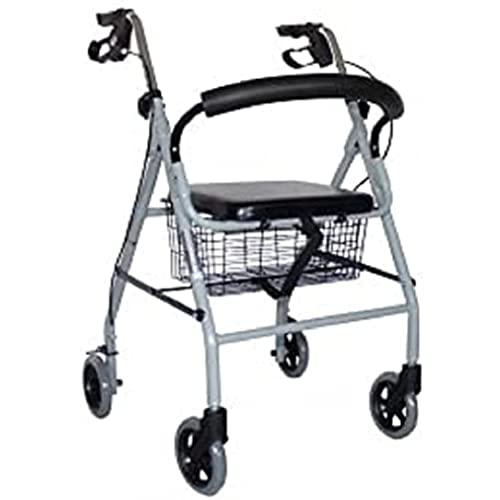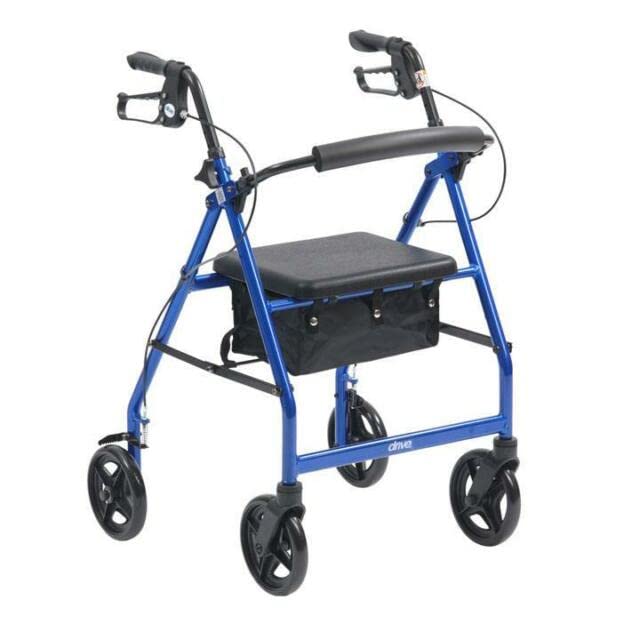You'll Never Guess This Walking Aid Rollator's Benefits
페이지 정보
작성자 Lucas 작성일 24-12-28 18:23 조회 6 댓글 0본문
 The Benefits of Walking Aid Rollator
The Benefits of Walking Aid RollatorWalking with a rollator can assist you in staying active and independent, while reducing fatigue and strain on muscles. You can improve your walking experience by choosing the best purple rollator walker for your needs, using it properly and adding accessories.
Four-wheeled rollators uk give you more balance and support, allowing you to walk on a variety of terrains indoors and outdoors. These rollators typically include storage, a seat and other features to increase your freedom.
Stability
Rollators provide a solid foundation for walking, which is particularly beneficial for people who have lost a portion of their balance due to injuries or the natural ageing process. Rollators distribute weight evenly, which eases pressure on the knees, ankles, and hips. They are also easy to maneuver through tight spaces, which is great for those with limited mobility or who have trouble holding and controlling traditional walkers.
The durability of a rollator improves its ability to provide support on non-natural surfaces, such as uneven or sandy ground. This allows people continue their routine activities while remaining active and involved in the community. For people whose mobility is restricted due to chronic conditions or surgery, the use of a rollator can mean the difference between maintaining independence or becoming dependent on others for assistance with daily tasks.
Walkers and rollators are alike in their fundamental functions, however they differ in terms of stability, manoeuvrability, as well as the option of sitting down. It's important to test both kinds of mobility aids in a variety of settings to determine which one best meets your needs and provides the most comfort. It is important to test them both indoors and outdoors on uneven and smooth surfaces for long distances, and in specific areas of your home, such as the bathroom or narrow doors.
Both walker models and the rolling walker are designed to provide the impression of mobility. However, the former can be folded for more convenient transport and storage. Many models have adjustable features, allowing users to adjust their handle height, seat depth, and brake tension for maximum comfort and safety. The frame of a walker with wheels is usually made of lightweight materials such as aluminum, which makes it easier to maneuver and control. This is also true for the wheels, which are crafted from lightweight rollators and sturdy materials to maximize performance without losing the durability.
Comfort
A walker rollator can be beneficial to those who suffer from temporary walking disabilities. They can reduce the risk of falling, and also reduce the strain on muscles and joints which are healing. This allows for a quicker and more comfortable healing while also helping you maintain a healthy lifestyle.
There are a variety of walkers that are available, each with a variety of features to meet the specific needs of each user. There are different handlebar heights and brake options that can meet the individual mobility needs of each individual. Some models also have a built-in seat that provides a stable support on four wheels so users can relax and sit whenever they want to. The seats with padding are usually designed to fold away, so the device can be transported easily when not in use.
The ergonomics of a walking aid rollator are also extremely important to ensure safety and comfort. The handles of a walker are typically constructed of plastic, foam or other soft materials that are shaped to fit the wrists to ensure maximum comfort when gripping. Many walkers come with extra accessories that increase comfort. These include bag hooks as well as umbrella holders, beverage holders, and holders for smartphones.
Talk to your occupational or physical therapy provider to determine the most appropriate solution for your mobility needs. Rollators and walker are ideal for those who require additional stability while walking, especially older people who are more susceptible to falling. These simple mobility aids can prevent falls that could result in expensive hospital bills and life-altering injury.
Some walkers and rollsators can be folded down to transport them in buses, cars and other vehicles. However, if you need to transport your walker without the option of folding it down, it's worth investing in ski glides or rubber tips to help move the walker on its wheels. These can be purchased online or from specialist retailers like Essential Aids. They provide the security and durability that is easily attached to the walker by using plastic clips.
Mobility
If you or someone you love is struggling with mobility challenges the rollator might be the ideal mobility aid. Common indications for the use of rollators include recovering from a surgery or injury dealing with chronic illnesses like arthritis or multiple sclerosis or simply having problems with mobility due to age. The aid provides stability and support, allowing individuals to walk further distances and improve their posture.
Unlike standard walkers, which only have wheels on the front two legs, rollators come with wheels on all four legs, allowing greater maneuverability. They can get to places that regular walkers may not be able and make more precise turns. Furthermore, some walking strollers have seats that allow users to sit for balance and rest when required.
Rollators offer greater mobility, allowing you to live your life and move about more easily. This can lead to higher quality of life. Research has shown that walking on a rollator may reduce the strain placed on joints and muscles. This is because rolling with a rollator relieves the knee and ankle extensors and allows other muscles to create movement and reducing strain on knee joints and other hip and leg joints.
Rollators are small and light which makes them easy to store and transport when not in use. Many models come with storage options such as baskets, pouches, or trays that can keep personal items and medical supplies within reach while on the go.
Essential Aids offers a variety of wheeled walkers. Some models come with extra-thick, softly cushioned seats that are comfortable for long periods of time. Certain models come with removable backs, which allow you to sit in a comfortable position while sitting on the rollator. To find out more about the benefits of a roll-walker or to figure out which model is best for you, consult with a qualified occupational therapist. They can offer expert advice and help in choosing the most suitable mobility aid for your needs.
Safety
A rollator is a mobility aid that improves independence and mobility. To achieve this it must promote stability and comfort, offer a seat and offer an ensconced grip. It must also be robust and easy to move and have reliable braking systems. These are essential to ensure the safety of users as well as satisfaction.
The core of every rollator is its frame, which must be lightweight to make it easy to move but strong enough to hold a user's weight. Aluminum is the most common material used for frames for rollators because it offers an extremely stable base that is easy to turn and push. Steel frames are also available to those who need a little more strength than standard aluminum models.
A hand brake that can be locked is necessary to stop the rollator from slipping off the user. This feature is typically found on the handlebars and can be used when walking to regulate the speed of the device. The brakes on a walker is not meant to substitute the proper positioning of your feet or a well-balanced posture.
A walker or rollator could be a fantastic aid to mobility for those with impaired muscle function and balance issues. However, it is essential to speak with a medical professional to determine which mobility aid is suitable for your specific needs and limitations. A healthcare professional can offer personalized advice, help you determine the best mobility aid to suit your needs and help you navigate any possible complications that might result from using the aid of walking.
Rollators and Walkers differ in many ways. From their frames, to their handles and even their built-in seats. Walkers have four legs that are able to touch the ground, while rollators have four or three wheels. This difference in function makes a huge difference in how easily the device can be moved as well as the amount of pressure it exerts on the knees, hips and ankles, as well as the spine.
 The wheels on a rollator distribute the weight of the user more evenly. This reduces stress on the lower joints and decreases the risk of falling. The wheels on a walker are designed to aid in movement and help users navigate difficult terrains with ease.
The wheels on a rollator distribute the weight of the user more evenly. This reduces stress on the lower joints and decreases the risk of falling. The wheels on a walker are designed to aid in movement and help users navigate difficult terrains with ease.- 이전글 Five Killer Quora Answers To ADHD Medications For Adults
- 다음글 ChatGPT Nederlands - Chat GPT Online Zonder Registratie
댓글목록 0
등록된 댓글이 없습니다.